What is 1st, 2nd, 3rd, and Zero Party Data? A Guide for eCommerce Brands

As an online brand, your customer data is your biggest competitive advantage, but only if you know how to collect, manage, and activate it effectively.
By handling your data strategically, you can understand your customers better, identify where they are in their buying journey, and deliver more personalized, relevant experiences.
In this guide, we'll dive into the four types of customer data that eCommerce brands usually work with. You’ll learn how each type can support your brand and how to leverage them to personalize experiences, improve targeting, and grow your business.
Four customer data types that eCommerce brands can use
There are four main types of customer data that you can collect, each with its own methods, implications, and value:
1. First-party data: You collect this data directly through owned channels.
2. Second-party data: This is collected by a trusted partner and shared with you through a formal agreement.
3. Third-party data: This is collected by an external provider that aggregates data from multiple sources and sells it to businesses.
4. Zero-party data: Your customers proactively and intentionally share information with you through surveys, quizzes, etc.
Let’s explore all four in detail.
What is first-party data?
First-party data is information that your business collects directly from your customers, site visitors, and other audiences through your owned channels like website, mobile app, emails, loyalty program, or physical stores.
It is captured through different kinds of consented interactions:
- Website interactions, like customer registration, web analytics, and online behavior
- Transactional data, such as purchase history, order details, payment preferences, and fulfillment details
- Engagement data, like email opens, loyalty program participation, and SMS clicks.
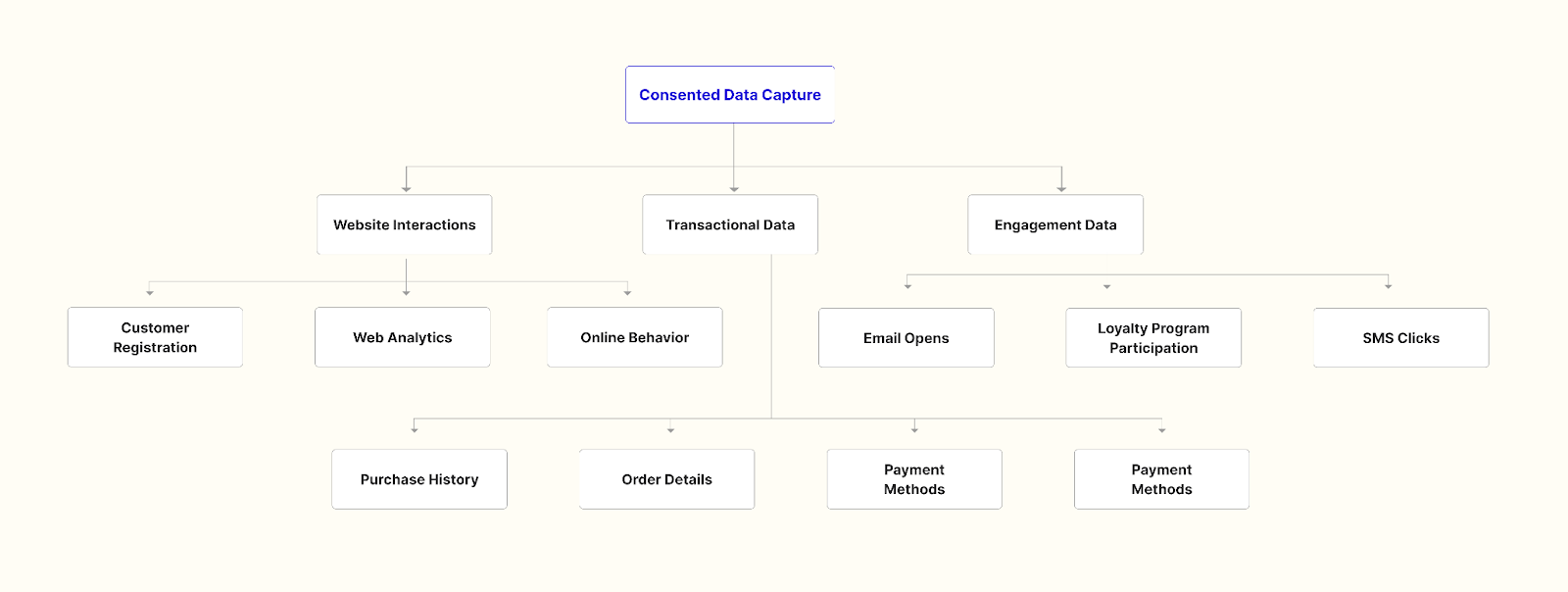
What is first-party data in marketing, and what does it include?
Depending on the type of business you run, the kind of first-party data you collect will differ. Here’s what first-party data typically includes for eCommerce brands:
- Demographic details: Age, education, employment, marital status, etc.
- Interests: Products browsed, favourite product categories, wishlists, and preferred type of promotions
- Location: Shipping address and billing address
- Purchase history: Products purchased, bundles or subscriptions bought, successful cross-sells or upsells, total order value, and customer lifetime value
- Payment preferences: Preferred payment methods (e.g., PayPal, credit card, Apple Pay, BNPL options).
- Return and refund behavior: Shoppers returning items, return rate, patterns in refund requests.
- Loyalty program or membership status: Tier status within loyalty program, accumulated points, and reward redemption history
- Coupon behavior: Whether the customer uses discount codes, if they exclusively use coupons, likelihood of conversion with a coupon, etc.
- Social media engagement: Platforms where a customer follows or interacts with your brand (like Instagram, TikTok, Facebook, etc)
Why is first-party data important, and how does it benefit brands?
First-party data is one of the most valuable assets for brands. It’s collected directly from your customers, making it accurate, compliant with data privacy regulations (like GDPR and CCPA), and unique to your business.
You can use this data to remarket to shoppers, personalize your customer experience, and leverage the right retention strategies to increase repeat purchases and build customer loyalty.
Here are five ways that this personal data benefits eCommerce brands:
1. Understand customer preferences: Track browsing, purchasing, and engagement behavior to learn what products and offers resonate with your shoppers.
2. Personalization: Use real-time behavioral and transactional data to set up personalized marketing messages and offers that feel relevant and are more likely to convert.
3. Build trust and loyalty: The data you’ve collected allows you to cater to your customers’ needs, allowing you to foster a long-term relationship with them.
4. Set up better customer experiences: Using your data, you can anticipate customer needs, tailor your recommendations, and speed up checkout, delivering a positive experience for your customers and making them more likely to return.
5. Identify patterns to improve offerings: First-party data lets you analyze trends in purchases, returns, and browsing habits. You can use this to optimize your product, pricing, and promotions.
What challenges do brands face when handling first-party data?
While first-party data is one of the most trusted data sources, brands still face limitations in managing it effectively.
1. Integrating and organizing: Data lacks a unified view, often because it is hosted across multiple tools.
2. Fragmented profiles: Sometimes, the same customer is listed as two separate profiles.
3. Linking cross-device activity: Shoppers move between multiple devices, but many brands don’t connect these sessions as a single journey.
4. Missing key identifiers: Customers often browse without sharing any details about themselves, leading to anonymous profiles that brands can’t target.
5. Updating profiles in real-time: If first-party data is not synced automatically, brands end up working with past data.
6. Activation gaps: Brands miss out on the opportunity to target shoppers because they don’t push their data to their marketing channels.
7. Measuring performance across touchpoints: Lacking centralized data makes it hard to connect campaigns to real outcomes like cart additions or purchases.
8. Maintaining compliance: You need to continuously update your customer data as users opt out, unsubscribe, or change their information.
How to solve these issues
Identity resolution tools like Tie help eCommerce brands to unify, enrich, and activate their first-party data. The platform merges fragmented data into single, unified customer profiles, enriches incomplete profiles with third-party data, and syncs data in real-time, maintaining privacy compliance throughout the process.
Want to know more? Book a demo to understand how Tie can help you improve your eCommerce brand’s first-party data.
What is an effective first-party data strategy?
Your first-party data is only as powerful as the way you collect, organize, and use it. But what do you need to do to figure out how to get first-party data and start using it for marketing and optimization?
Here’s how to build an effective first-party data strategy for your eCommerce brand:
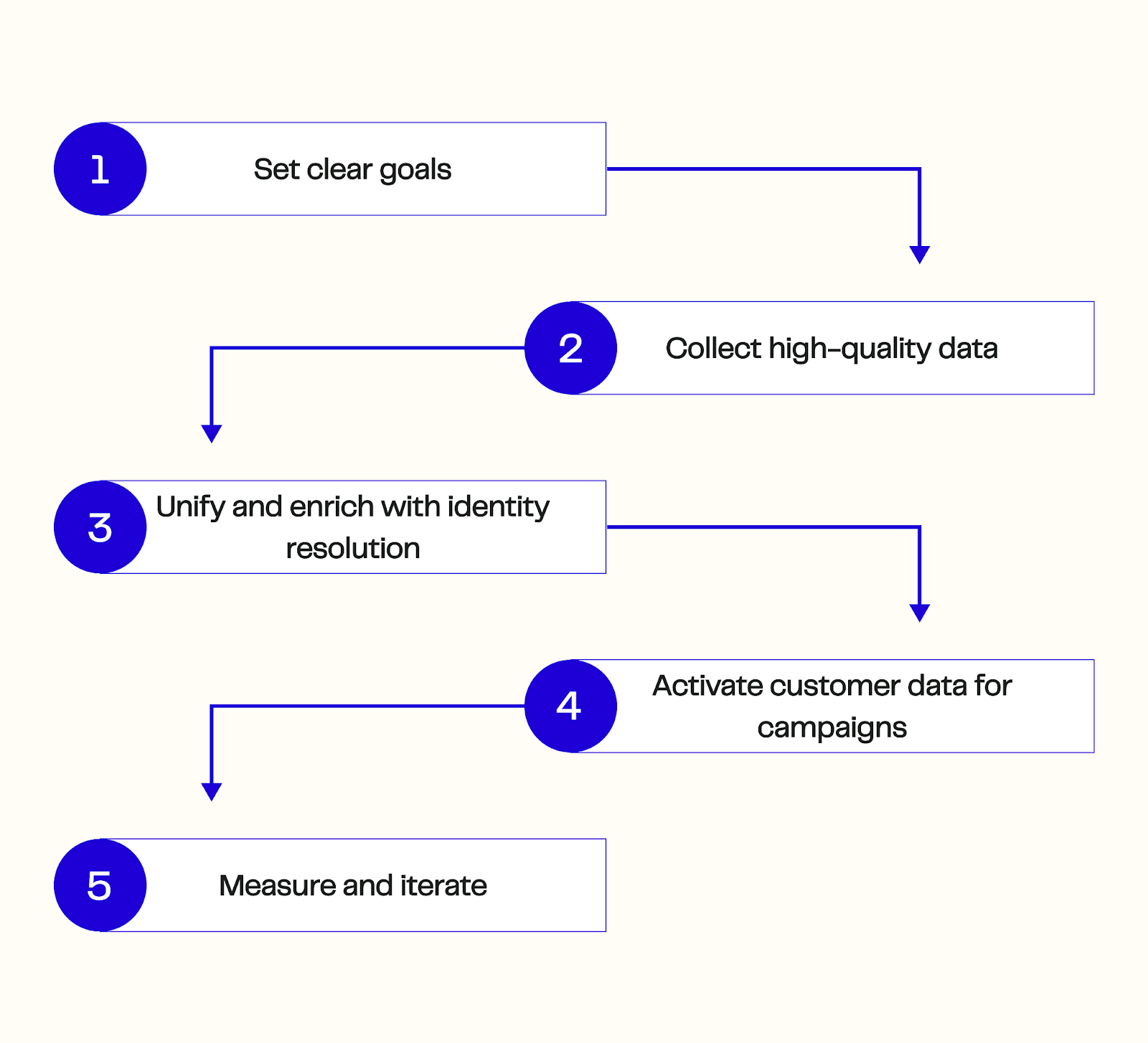
1. Set clear goals
Define what you want to achieve with your data, like boost loyalty, increase average order value, or build lookalike audiences. This is especially important to help you set up an effective marketing strategy.
2. Collect data thoroughly
Capture high-quality data at every customer touchpoint— website behavior, purchases, loyalty program, activity, and checkout submissions.
3. Set up identity resolution to unify and enrich
Connect customer actions across sessions, devices, and channels, ensuring that each shopper has one unified profile and avoiding fragmented data within your CRM. Tools like Tie are built to set up consolidated and accurate customer data within your CRM and enrich profiles with missing attributes like browsing interests and payment preferences.
4. Activate customer data for marketing and retention
Sync your accurate customer profiles in real time into your marketing tools. This allows you to use this data to optimize email marketing campaigns, build precise audience segments for targeting, and trigger retention flows that keep customers engaged and coming back.
5. Measure and iterate
Track how your first-party data strategy impacts KPIs like conversion rate, retention, and customer lifetime value. Use performance insights to refine first-party data collection methods, enrich profiles further, and optimize activation tactics over time.
Is Google Analytics first-party data?
Yes, Google Analytics uses first-party cookies to track user behavior on your website. The data it collects (page views, sessions, purchases, etc.) belongs to you.
Can you onboard and target first-party data on YouTube?
YouTube allows you to upload your first-party customer lists (like email addresses, phone numbers, or mailing addresses) through “Customer Match”, a feature within Google Ads. This allows you to target your existing customers with personalized ads across YouTube, Gmail, and the Google Display Network.
Tools to manage first-party data
Your eCommerce brand needs the right tools to manage your first-party data for collection, enrichment, and activation. Here are three tools we recommend:
1. Shopify: Native eCommerce platform
Shopify automatically collects first-party data from your store activity. This includes purchases, order values, repeat customers, and product trends, giving you insights into how your business is running.
However, Shopify has its limitations. It doesn't let you uncover anonymous shoppers, tracking only known purchasers. Shopify may also store the same customer as multiple profiles if customers can clear their cache or shop from various devices and emails.
This is why many leading eCommerce brands rely on identity resolution and data enrichment platforms like Tie to improve their datasets and ensure they’re working with accurate and consolidated customer data.
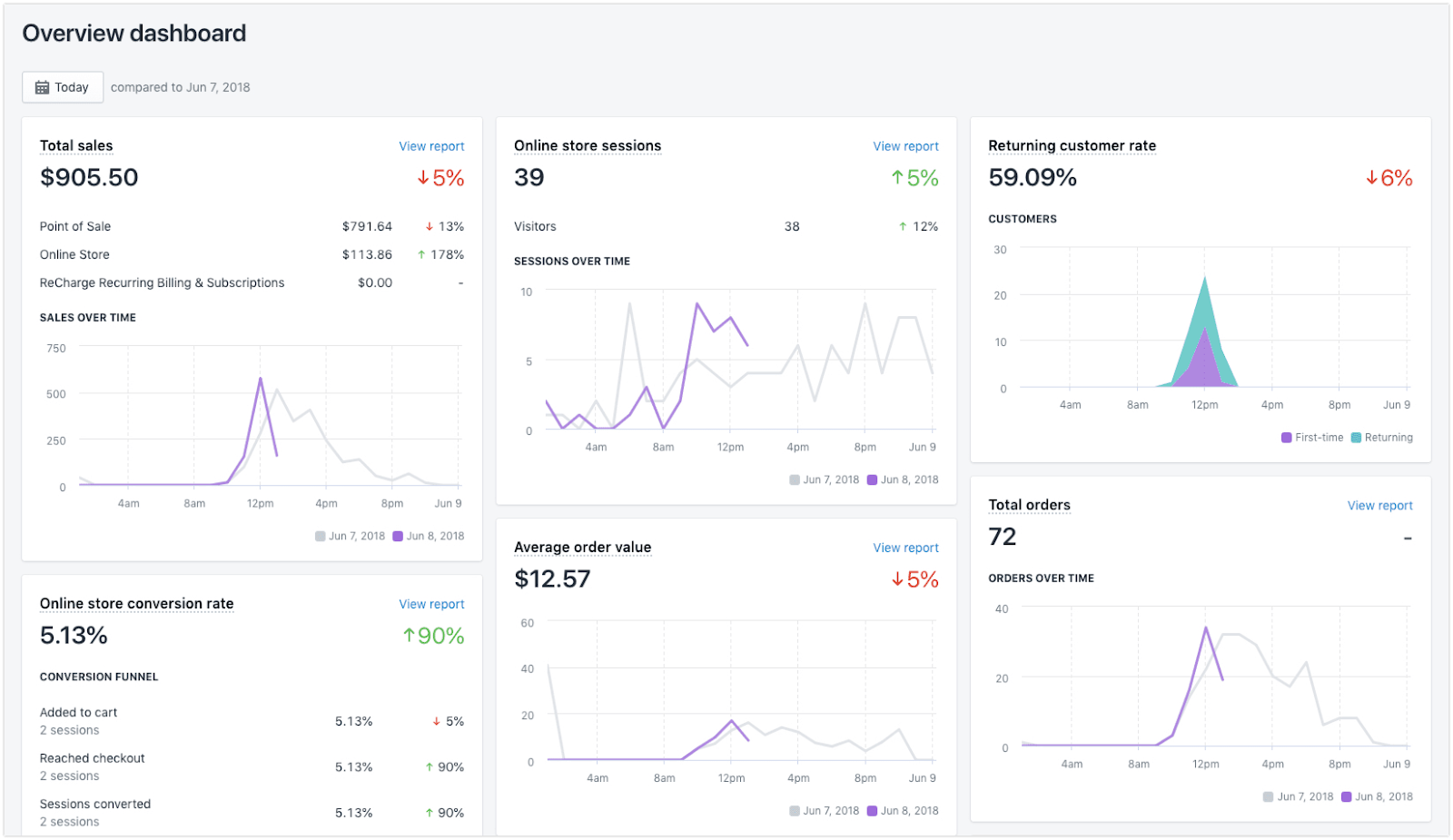
2. Tie: Data enrichment and identity resolution platform
Tie is an identity resolution platform that enriches your website visitor data. Here’s what it does:
- Consolidates customer profiles, removing duplicates and maintaining accuracy.
- Accurately uncovers anonymous shoppers by relying on its identity graph (a database network of consented third-party data).
- Allows you to filter your audience, pick who you want to track or de-anonymize based on actual web behavior, intent, or demographic attributes.
- Lets you set up customer segments
3. Klaviyo: Marketing tool
Klaviyo is an omnichannel marketing tool that allows brands to activate their first-party data, using it to personalize their email, SMS, and push notification campaigns.
Since it integrates with platforms like Shopify and Tie, Klaviyo helps you set up behavior-driven automation flows that reach different types of customers with the right message, triggered at the right time.
By using accurate and holistic customer data and setting up precise automated messages, you can effectively reach customers, engage them better, and increase conversions.
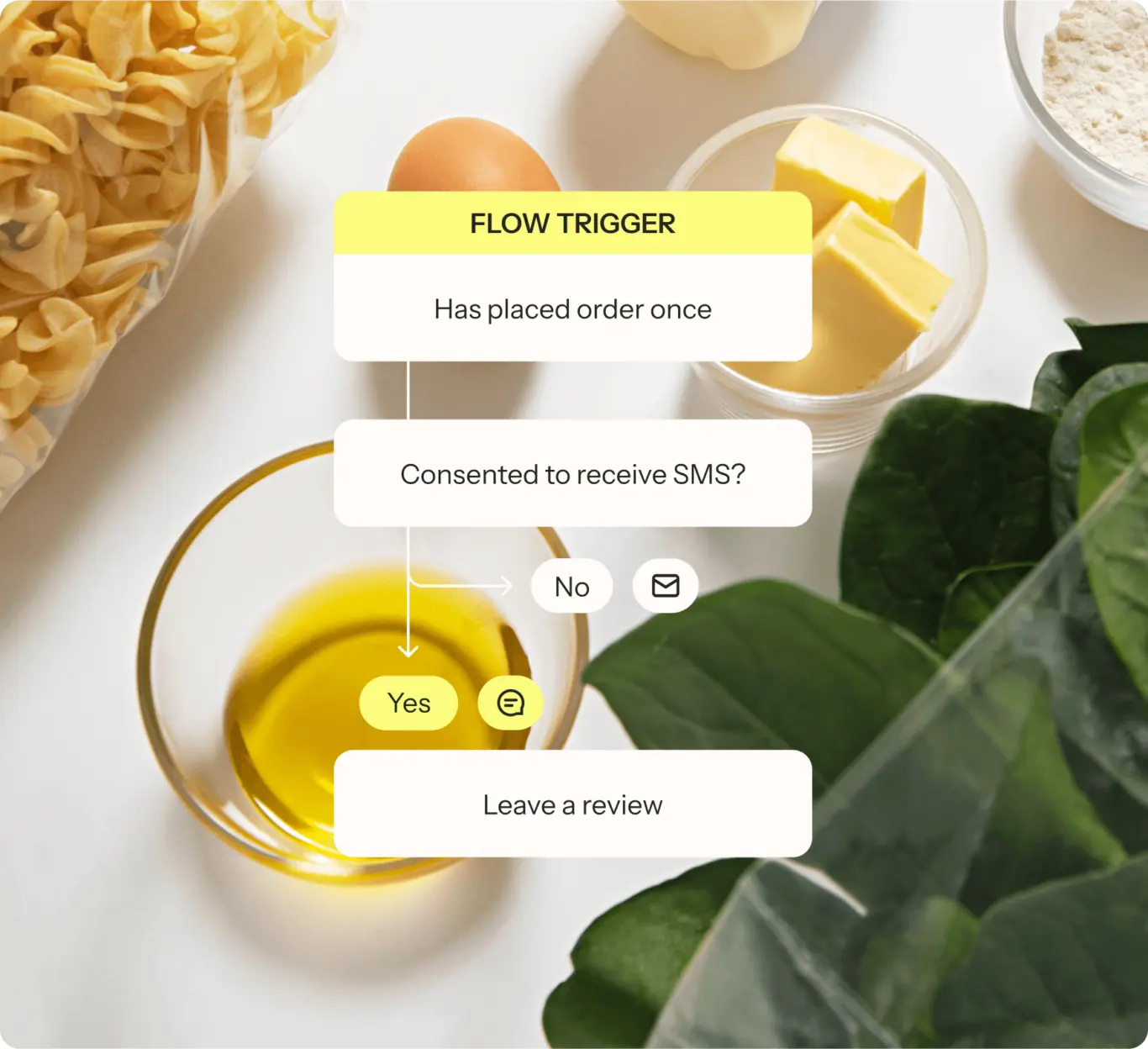
Other marketing tools you can use to activate your first-party data include Omnisend, Attentive, etc. Learn more about the different marketing tools you can use to engage with your customers.
Use cases: How to leverage first-party data
When set up right, your first-party data can support your eCommerce business across the entire customer journey. Here are seven ways to use your first-party data:
1. CRM enhancement
First-party data within your CRM allows you to improve your communication, provide better customer support, and personalize your marketing efforts.
2. Audience segmentation and targeting
Use behavioral, transactional, and demographic identifiers to create audience segments. Set up personalized campaigns targeting different segments like repeat buyers, discount shoppers, or high AOV customers to capture more purchases.
3. Exclusive discounts
Identify which shoppers respond best to offers to reward loyal customers, re-engage dormant ones, and incentivize high-intent browsers with relevant discounts.
4. Optimize email marketing campaigns
If you’re wondering how to use first-party data for email marketing, the answer lies in personalization at every stage of the customer journey. With first-party data, you can send relevant campaigns and set up triggered flows based on real customer interactions and behavior.
By relying on real behavioral signals, you can send abandoned cart reminders, post-purchase emails, replenishment reminders, loyalty celebration emails, and winback nudges that your shoppers are sure to engage with.
5. Improve retention
First-party data marketing personalization can improve your retention efforts as well. By identifying repurchasing and churn patterns, you can send timely reorder reminders and re-engagement offers.
6. Set up relevant upsell and cross-sell
Use insights into purchasing patterns, cart value, and browsing behaviour to recommend products that would be best paired with products that your customers have enjoyed. Set up smart upsell and cross-sell offers to increase your average order value.
7. Improve product offerings
Spot trends in how customers are shopping. Here are some product-related trends you can spot:
- Popular products
- Products that are returned more often
- Products bought only with a discount
- Slow-moving inventory
- Products that are commonly bought together
Based on this, you can make better inventory decisions, improve how you stock your products, launch new products that align with customer preferences, and refine your strategy.
What is second-party data?
Second-party data is another brand’s first-party data that your brand gains access to through a trusted partnership. It’s collected directly by your partner (usually through their website or campaigns) and shared with you through a formal agreement.
The partnership is usually with brands that serve a similar audience but aren’t direct competitors.
For example, a skincare brand could get access to a list of health-conscious shoppers from a wellness supplement brand they’ve partnered with. The skincare brand can now use this data to show Instagram ads to these shoppers, introducing them to their products subtly.
These high-intent audiences are more likely to click through on the ad and convert into followers or buyers.
You can use second-party data to directly promote your brand via email, build lookalike audiences to run ads, tailor offers to these new potential customers, launch joint product bundles, etc.
Benefits and challenges of using second-party data
Second-party data can help brands expand their reach, making it especially valuable for businesses that are just starting out or facing stagnant growth.
- High data quality and accuracy: It’s first-party data at the source, making it trustworthy.
- Audience relevance: Since partnerships are with brands that share the same ideal customer profile (ICP), they are likely to be relevant to your business.
- Privacy-compliant: When done correctly, second-party data sharing respects user consent and avoids shady practices.
- Faster than building from scratch: For new businesses with a budget, high-quality second-party data can help them start targeting relevant shoppers who are likely to convert without needing to build out their first-party dataset, which can take time.
Despite its upsides, brands do face some limitations when working with second-party data:
- Access and negotiation: Setting up formal data-sharing agreements or partnerships takes time and trust.
- Compatibility issues: Your partner may collect and format data differently from your systems, requiring extra time to clean, standardize, and integrate the data for your use.
- Consent clarity: You don’t always know how your partner collects data, making it hard to identify if the data shared was collected with consent.
- Volume limitations: Second-party data usually comes from a single brand or a group of partners. Since it’s tied to shared ideal customers, its size is limited to a niche but high-quality audience.
How to collect second-party data
Collecting second-party data comes down to building the right partnerships and coming to an agreement on how you’ll be collecting and sharing the data.
- Picking partners
- Pick complementary brands: Partner with brands that serve a similar audience without competing directly (e.g., a luggage brand and a travel booking platform).
- Publisher partnerships: If you advertise or sponsor content with media companies, they may share reader data in return.
- Pick complementary brands: Partner with brands that serve a similar audience without competing directly (e.g., a luggage brand and a travel booking platform).
- Plan of action for lead collection and sharing
- Host co-branded campaigns: Run a quiz, survey, or event together and agree to share the collected leads (with user consent).
- Lead-sharing agreements: Set up partnerships where both brands agree to exchange qualified leads collected independently through their own campaigns.
- Host co-branded campaigns: Run a quiz, survey, or event together and agree to share the collected leads (with user consent).
What is third-party data?
Third-party data is information collected and aggregated by external companies from a variety of sources and sold to brands for targeting and advertising.
Identity resolution and data enrichment platforms like Tie use an identity graph that includes a network of 250 data points across millions of customers that has been collected consensually. The platform then uses this to enrich an eCommerce brand's customer profiles, uncovering anonymous shoppers and enriching existing customer profiles with data that allows the brand to better target them.
Benefits and challenges of third-party data
Third-party data transforms your brand’s first-party customer details to improve your datasets and offer newer marketing opportunities:
- Uncover anonymous shoppers by matching IP addresses and behavioral data to verified profiles, letting you identify and target shoppers you otherwise wouldn’t have been able to reach.
- Reduce cart abandonment by retargeting abandoners who used to be anonymous with email, SMS, and paid ads.
- Access demographic and behavioral traits like age ranges, interests, income levels, and shopping habits to build richer customer profiles.
- Target customers more precisely using enriched data to create specific audience segments and set up relevant digital marketing campaigns.
- Improve personalization by setting up marketing automations tailored to your enriched customer profiles and including relevant dynamic content that resonates with shoppers.
While third-party data offers many benefits, eCommerce brands need to choose the right partner carefully. If not, you can run into these issues:
- Low-quality or unverified data sources.
- Risk targeting the wrong audiences
- Breaking data privacy laws due to a lack of proper consent.
- Wasted ad spend due to ineffective customer datasets.
- Damaged customer trust.
How to collect third-party data
Platforms like Tie help brands access high-quality, privacy-compliant third-party data by working only with trusted and consented data sources.
Here’s how it works:
- Tie’s proprietary identity graph includes a network of 250 data points across millions of customers collected consensually.
- This allows the platform to match anonymous shoppers to known identifiers, uncovering anonymous shoppers and enriching existing customer profiles with data points they otherwise wouldn’t have access to.
- The brand now has enriched profiles that are synced with its CRM, ESP, and ad platforms in real time, simplifying activation.
- With better customer data, eCommerce brands can identify high-intent shopper segments (like frequent browsers, high-value shoppers, and cart abandoners) to target them with relevant and personalized marketing messages to bring them back to shop.
First vs. third-party data
If eCommerce brands already have first-party data in place, do they need third-party data? Let’s dive into how both differ and why using them together often drives the best results.
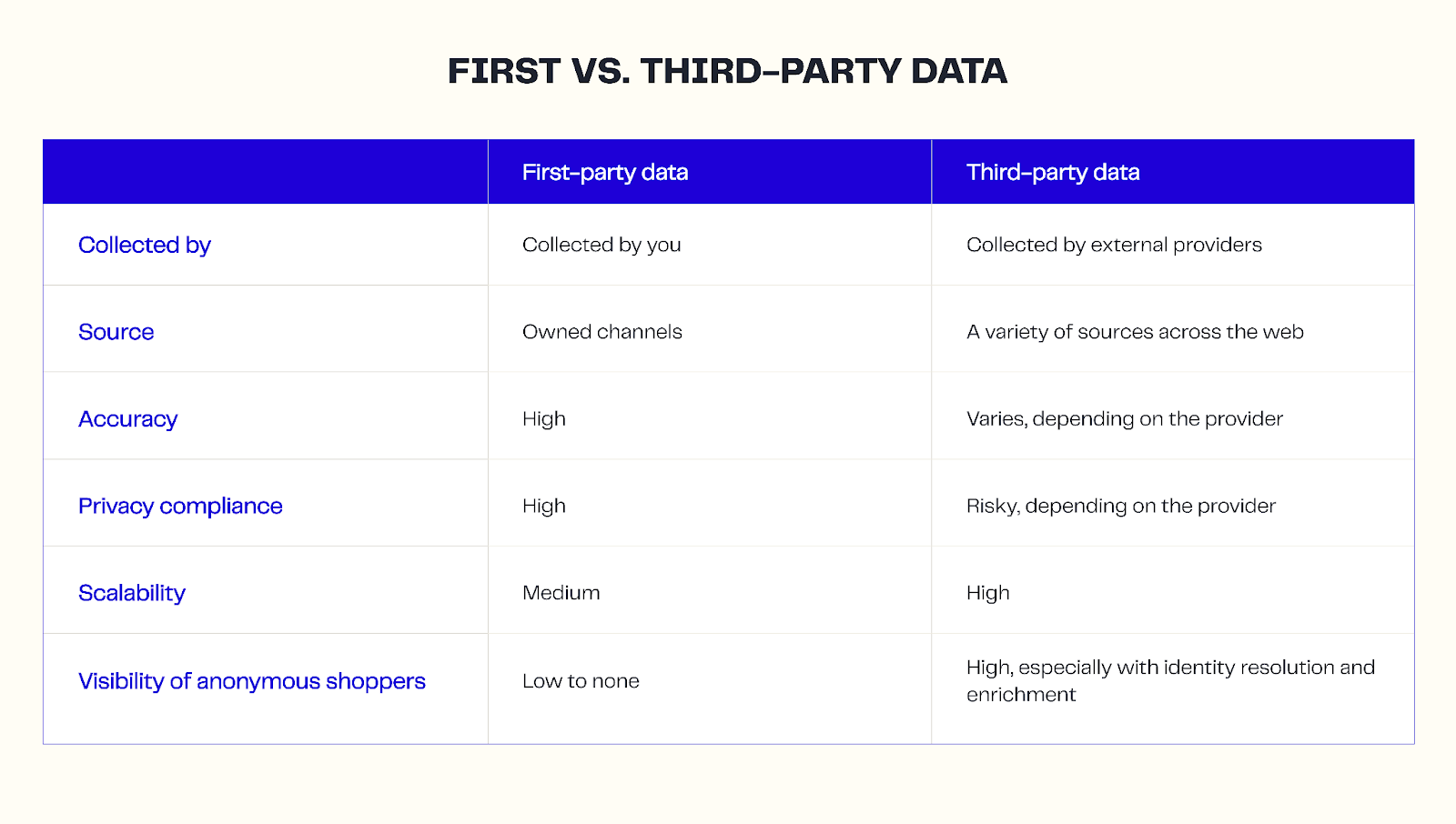
First-party data is highly accurate and unique to your brand, but it has limitations. It doesn’t allow you to uncover anonymous shoppers, identify cart abandoners who haven’t opted in, or reach new high-intent audiences. Third-party data fills these visibility gaps.
The right third-party data sources give you access to behavioral and demographic insights, reveal anonymous website visitors, and expand your audience size beyond your existing customers. With these additional data points, you can convert high-intent shoppers, acquire new customers, and improve your personalization using intent signals and demographic attributes you wouldn’t otherwise have.
Most brands use both together, starting with first-party data and layering in third-party enrichment to identify anonymous shoppers and build a more holistic view of their customers.
What is zero-party data?
Zero-party data is information that customers intentionally and proactively share with a brand. While first-party data is inferred from behaviour or collected for other purposes (like during purchases or sign-ups), zero-party data is collected through explicit interactions like quizzes, surveys, account settings, or product finders.
Benefits and challenges of zero-party data
With the right strategy, zero-party data allows you to capture insights that other kinds of data can’t provide:
- Accurate and detailed: You get honest customer feedback about your products, their preferences, and their values, reflecting the true needs of your customers.
- Highly compliant: Since customers actively share this information, the data you collect is compliant.
- Personalization capabilities: Using these insights, brands can personalize recommendations, content, and offers.
However, collecting zero-party data takes some effort and has its limitations:
- High customer motivation: Customers need to be willing to engage and share information. Many brands offer an incentive to their customers to fill out their survey or take their product quiz.
- Changing preferences: Since preferences change over time, brands can’t rely on the data for a long period. Instead, they need to refresh and update this information periodically.
How is zero-party data collected?
Brands collect zero-party data by creating touchpoints where customers are encouraged to share their preferences or intentions:
- Product finder quiz
- Onboarding surveys
- Preference centers
- Post-purchase feedback forms
- Interactive content and polls
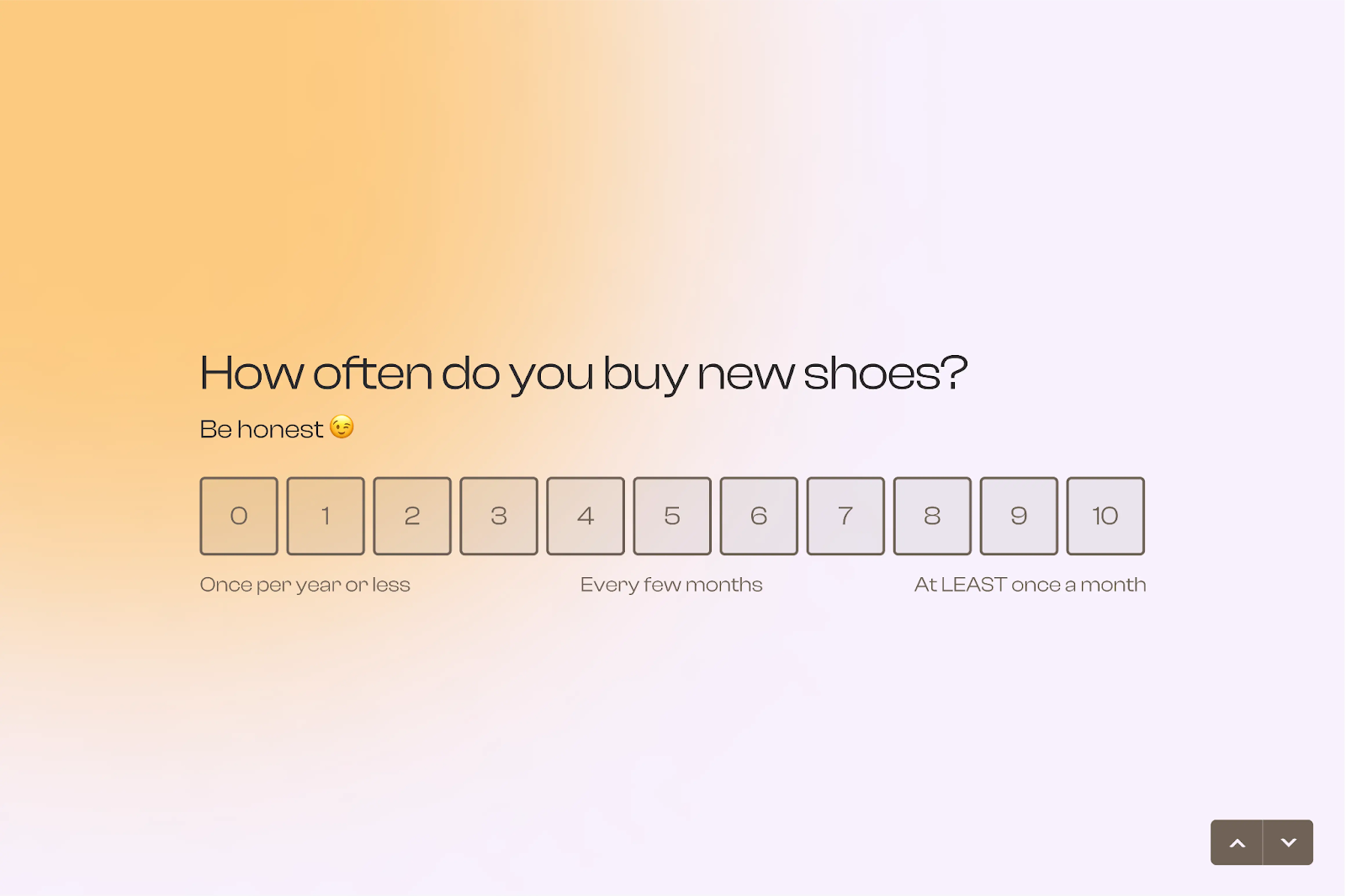
Best practices for using different types of customer data together effectively
Using all 4 types of data together and strategically can allow you to identify patterns, refine your marketing efforts, and improve the customer experience you deliver. Here are seven best practices to keep in mind to use your customer data to your advantage:
1. Maintain your first-party data: Make sure that your foundation is strong by collecting and organizing your existing customer data correctly.
2. Leverage third-party data to enrich your existing data: Trusted identity resolution platforms like Tie match anonymous site visitors to real profiles and enrich your first-party data, uncovering demographic and behavioral attributes you wouldn’t otherwise have access to.
With this, you can build better customer segments and improve your targeting.
3. Increase personalization with zero-party data: Host quizzes, surveys, and polls to capture explicit data from customers on their preferences. You can use this to improve your products, offers, and messaging.
4. Unify your data sources: Centralize all your data into one CRM or customer data platform (CDP). Unified customer profiles hosted in one place allow you to see their journey across multiple touchpoints and leverage these insights to improve the experience you deliver to your customers.
5. Build customer segments to power your marketing: With better data, you can now build smart customer segments based on purchase history, customer behavior, intent, and demographics. Use them to set up automated email flows, SMS campaigns, and retargeting ads that allow you to increase your reach, send relevant messages, and drive more conversions.
6. Keep your data clean and updated: Regularly validate your customer profiles, remove duplicate data, and ensure that you maintain accurate and updated information. Tools like Tie keep your data fresh, syncing it directly to your CRM, ESP, and CDP automatically, making it ready for you to use.
Remove outdated or inactive customers from your segments to maintain email deliverability and engagement.
7. Maintain compliance: Ensure all collected data is sourced with explicit user consent. Make it easy for customers to update their preferences, opt out, or request data deletion—building long-term trust and protecting your brand.
How Tie unifies data for smarter targeting
Leading eCommerce brands don’t just collect their data, but they set it up in a way that it works for them. By unifying different data sources, setting up holistic customer profiles, and activating them for better marketing and customer experience, brands can engage shoppers better, increase their sales, and improve retention.
This is how Tie can help. Tie helps brands improve their data to leverage it better. By uncovering anonymous visitors, enriching customer profiles, and syncing real-time updates into your CRM and ESP, Tie ensures that you’re working with accurate data to power your operations better.
With this, you can identify high-intent shoppers and convert them, build smarter customer segments, personalize your marketing efforts, and increase revenue.
Ready to transform your eCommerce brand’s data with unified and enriched customer profiles?







